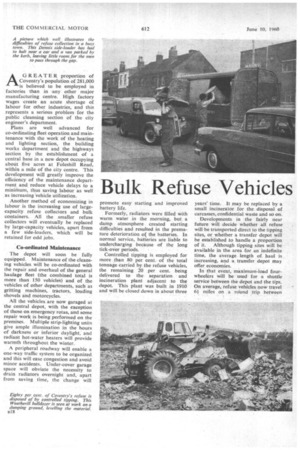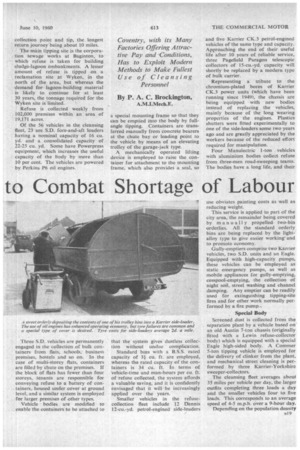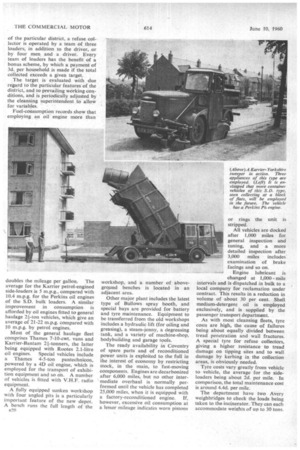Bulk Refuse Vehicles to Combat Shortage of Labour
Page 52

Page 53

Page 54

If you've noticed an error in this article please click here to report it so we can fix it.
By P. A. C. Brockington,
AGREATER proportion of Coventry's population of 281,000 is believed to be employed in factories than in any other major manufacturing centre. High factory
wages create an acute shortage of labour for other industries, and this represents a serious problem for the public cleansing section of the city engineer's department.
Plans are well advanced for co-ordinating fleet operation and main tenance with the work of the heating and lighting section, the building works department and the highways section by the establishment of a central base in a new depot occupying about five acres at Foleshill Road, within a mile of the city centre. This development will greatly improve the efficiency of the maintenance depart ment and reduce vehicle delays to a minimum, thus saving labour as well as increasing vehicle utilization. Another method of economizing in labour is the increasing use of largecapacity refuse collectors and bulk containers. All the smaller refuse collectors will eventually be replaced by large-capacity vehicles, apart from a few side-loaders, which will be retained for odd jobs.
Co-ordinated Maintenance
The depot will soon be fully equipped. Maintenance of the cleans ing vehicles will be co-ordinated with the repair and overhaul of the general haulage fleet (the combined total is more than 150 vehicles) and of the vehicles of other departments, such as gritting machines, tractors, loading shovels and motorcycles. • All the vehicles are now garaged at the central depot, with the exception of those on emergency rotas, and some repair work is being performed on the premises. Multiple strip-lighting units give ample illumination in the hours of darkness or inferior daylight, and radiant hot-water heaters will provide warmth throughout the winter.
A peripheral roadway will enable a one-way traffic system to be organized and this will ease congestion and avoid minor accidents. Under-cover garage space will obviate the necessity to drain radiators overnight and, apart from saving time, the change will promote easy starting and improved battery life.
Formerly, radiators were filled with warm water in the morning, but a damp atmosphere created starting difficulties and resulted in the premature deterioration of the batteries. In normal service, batteries are liable to undercharging because of the long tick-over periods.
Controlled tipping is employed for more than 80 per cent. of the total tonnage carried by the refuse vehicles, the remaining 20 per cent. being delivered to the separation and incineration plant adjacent to the depot. This plant was built in 1910 and will be closed down in about three years' time. It may be replaced by a small incinerator for the disposal of carcasses, confidential waste and so on.
Developments in the fairly near future will decide whether all refuse will be transported direct to the tipping sites, or whether a transfer depot will be established to handle a proportion of it. Although tipping sites will be available in the area for an indefinite time, the average length of haul is increasing, and a transfer depot may offer economies.
In that event, maximum-load fourwheelers will be used for a shuttle service between the depot and the tips. On average, refuse vehicles now travel 6+ miles on . a rotund trip between _ . collection paint and tip, the longest return journey being about 10 miles.
The main tipping site is the corporation sewage works at Baginton, to which refuse is taken for building sludge-lagoon embankments. A lesser amount of refuse is tipped on a reclamation site at Wyken, in the north of the area, but whereas the demand for lagoon-huilding material is likely to continue for at least 30 years, the tonnage required for the Wyken site is limited.
Refuse is collected weekly from • 102,000 premises within an area of 19,171 acres.
Of the 56 vehicles in the cleansing fleet, 23 are S.D. fore-and-aft loaders • having a nominal capacity of 16 Cu. yd. and a consolidated capacity of 22-25 cu. yd. Some have Powerpress equipment, which increases the useful capacity of the body by more than 10 per cent. The vehicles are powered by Perkins P6 oil engines.
Three S.D. vehicles are permanently engaged in the collection of bulk containers from flats, schools, business premises, hostels and so on. In the case of multi-storey flats, containers are filled by chute on the premises. If the block of flats has fewer than four storeys, tenants are responsible for conveying refuse to a battery of containers, housed under cover at ground level, and a similar system is employed for larger premises of other types.
Vehicle bodies are modified to enable the containers to be attached to a special mounting frame so that they can be emptied into the body by fullangle tipping. Containers are transferred manually from concrete bearers at the chute bay or loading point to the vehicle hy means of an elevating trolley of the garage-jack type.
A mechanically operated lifting device is employed to raise the container for attachment to the mounting frame, which also provides a seal, so that the system gives dustless collection without undue complication.
Standard bins with a B.S.S. rated capacity of 31 cu. ft. are employed, whereas the rated capacity of the containers is 34 cu. ft. In terms of vehicle-time and man-hours per cu. ft. of refuse collected, the system affords a valuable saving, and it is confidently envisaged that it will 'be increasingly applied over the years.
Smaller vehicles in the refusecollection fleet include 12 Dennis 12-cu.-yd. petrol-engined side-loaders and five Karrier CK.3 petrol-engined vehicles of the same type and capacity. Approaching the end of their useful life after 10 years of reliable service, three Pagefield Paragon telescopic collectors of 15-cu.-yd. capacity will shortly be replaced by a modern type of bulk carrier.
Representing a tribute to the chromium-plated bores of Karrier CK.3 power units (which have been running since 1949), the chassis are being equipped with new bodies instead, of replacing the vehicles, mainly because of the long wearing properties of the engines. Plastics shutters were fitted experimentally to one of the side-loaders some two years ago and are greatly appreciated by the workers because of the reduced effort required for manipulation.
Four Manulectric 1-ton vehicles with aluminium bodies collect refuse from three-men road-sweeping teams. The bodies have a long life, and their use obviates painting costs as well as reducing weight.
This service is applied to part of the city area, the remainder being covered by ma nu ally propelled two-bin orderlies. All the standard orderly bins are being replaced by the lightalloy type to give easier working' and to promote economy.
Gully-ernptiers comprise two Karrier vehicles, two S.D. units and an Eagle. Equipped with high-capacity pumps, these vehicles can he employed as static emergency pumps, as well as mobile appliances for gully-emptying, cesspool-emptying, the collection of night soil, street washing and channel damping. Any emptier can be readily used for extinguishing tipping-site fires and for other work normally performed by a fire pump.,
Special Body
Screened dust is collected from the separation plant by a: vehicle based on' an old Austin 7-ton chassis (originally fitted with a Lewin refuse-collector body) which is equipped with a special Eagle high-sided body. A Commer 5-ton tipping vehicle is employed for the delivery of clinker from the plant, and mechanical street cleaning is performed by three Karrier-Yorkshire sweeper-collectors.
The cleansing fleet averages about 35 miles per vehicle per day, the larger outfits completing three loads a day and the smaller vehicles four to. five loads. This corresponds to an average speed of 4-5 m.p.h. over a 9-hour day.
Depending on the population density of the particular district, a refuse collector is operated by a team of three loaders, in addition to the driver, or by four men and a driver. Every team of loaders has the benefit of a bonus scheme, by which a payment of 3d. per household is made if the total collected exceeds a given target.
The target is evaluated with due regard to the particular features of the district, and to prevailing working conditions, and is periodically adjusted by the cleansing superintendent to allow for variables.
Fuel-consumption records show that employing an oil engine more than doubles the mileage per gallon. The average for the Karrier petrol-engined side-loaders is 5 m.p.g., compared with 10.4 m.p.g. for the Perkins oil engines of the S.D. bulk loaders. A similar improvement in consumption is afforded by oil engines fitted to general haulage 21-ton vehicles, which give an average of 21-22 m.p.g. compared with 10 m.p.g. by petrol engines.
Most of the general haulage fleet comprises Thames 7-10-cwt. vans and Karrier-Bantam 21-tonners, the latter being equipped with Rootes 2.1-litre oil engines. Special vehicles include a Thames 4-5-ton pantechnicon, powered by a 4D oil engine, which is employed for the transport of exhibition equipment and so on. A number of vehicles is fitted with V.H.F. radio equipment.
A fully equipped sunken workshop with four angled pits is a particularly important feature of the new depot. A bench runs the full length of the 1320 workshop, and a number of aboveground benches is located in an adjacent area.
Other major plant includes the latest type of Bullows spray booth, and special bays are provided for battery and tyre maintenance. Equipment to be transferred from the old workshops includes a hydraulic lift (for oiling and greasing), a steam-jenny, a degreasing tank, and a variety of machine-shop, bodybuilding and garage tools.
The ready availability in Coventry of spare parts and of reconditioned power units is exploited to the full in the interest of economy by restricting stock, in the main, to fast-moving components. Engines are decarbonized after 6,000 miles, but no other intermediate overhaul is normally performed until the vehicle has completed 25,000 miles, when it is equipped with a factory-reconditioned engine. If, however, excessive oil consumption at a lesser mileage indicates worn pistons or rings the unit is stripped.
All vehicles are docked after 1,000 miles for general inspection and tuning, and a more detailed inspection after 3,000 miles includes' examination of brake facings and so on.
Engine lubricant is changed at 1,000 mile intervals and is dispatched in bulk to a local company for reclamation under contract. This results in a reduction in volume of about 30 per cent. Shell medium-detergent oil is employed exclusively, and is supplied by the passenger transport department.
As with most cleansing fleets, tyre costs are high, the cause of failures being about equally divided between tread penetration and wail fractures. A special tyre for refuse collectors, giving a higher resistance to tread damage on tipping sites and to wall damage by kerbing in the collection areas, is obviously needed.
Tyre costs vary greatly from vehicle to vehicle, the average for the sideloaders being about 2d. per mile. In comparison, the total maintenance cost is around 4.4d. per mile.
The department have two Avery weighbridges to check the loads being taken to the incinerator. They can each accommodate weights of up to 30 tons.




















































































































































